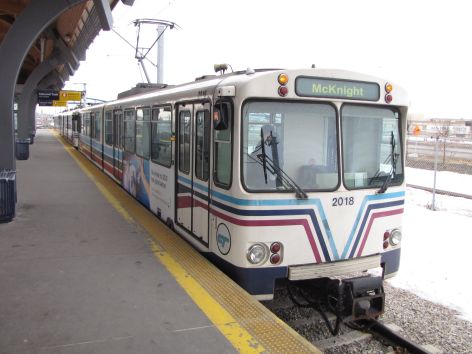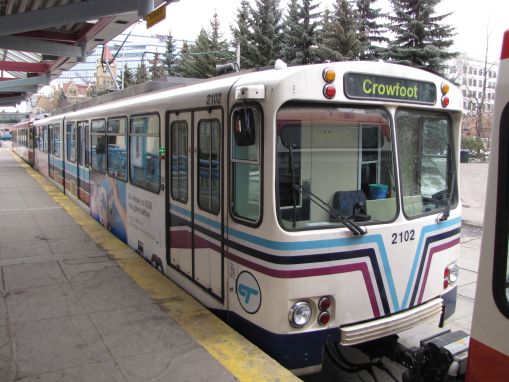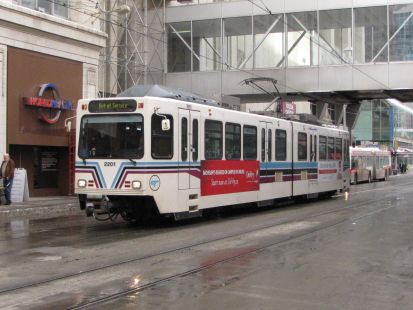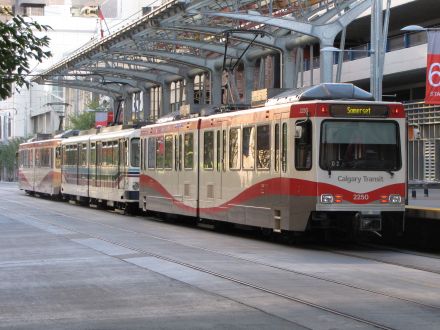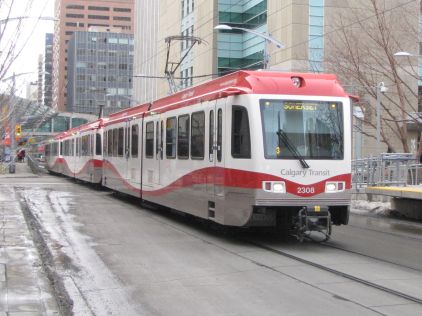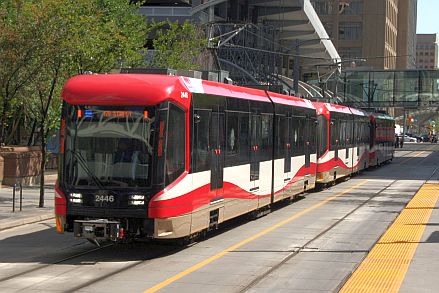For many years there was an extensive streetcar system within the city, serving CP’s Ogden shops in the southeast, Bowness Park in the northwest, and many of the communities along both sides of the Bow River. Service ended on 29 December, 1950 but some of the network was changed over to trolleybuses. The first trolleybus had run in 1947 and lasted until the early morning of 8 March, 1975. However this was not the end of electric powered vehicles in the city for later in 1975 several studies were completed proposing a modern light rail network. Approval was granted on 25 May, 1977 and construction started soon after with the first section of line being opened on 25 May, 1981 with the first train being driven by then Calgary Mayor, and later Alberta Premier, Ralph Klein.
Currently there are two routes, the original line, now known as the Red Line runs from Somerset / Bridlewood in the southwest to Tuscany in the northwest. Opened as the Blue Line it later became route 201 before becoming the Red Line. It first section was opened from Anderson to 8th Street SW in the downtown core and over the years has been extended, the most recent extension being to Tuscany in the northwest in 2014. At the time of writing there are plans to extend the line further south to Silverado and 210th Avenue SW. The tables below show the sections out of the downtown core, that will be dealt under a separate section as the two lines use the same tracks.
| Red Line – south section |
| Station |
Open |
Notes |
| Stampede |
25 May, 1981 |
Renamed Victoria Park / Stampede (1995) |
| Erlton |
" |
Renamed Erlton Stampede 1995) |
| 42nd Avenue |
" |
Renamed 39th Avenue (1996) |
| Chinook |
" |
- |
| Heritage |
" |
- |
| Southland |
" |
- |
| Anderson |
" |
- |
| Canyon Meadows |
9 October, 2001 |
- |
| Fish Creek – Lacombe |
" |
- |
| Shawnessy |
28 June, 2004 |
|
| Somerset – Bridlewood |
" |
- |
| Red Line – northwest section |
| Station |
Open |
Notes |
| Sunnyside |
7 September, 1987 |
- |
| SAIT/ACAD/Jubilee |
- |
Renamed SAIT/AUArts/Jubilee (2019) |
| Lions Park |
" |
- |
| Banff Trail |
" |
Serves McMahon Stadium |
| University |
" |
Serves University of Calgary |
| Brentwood |
31 August, 1990 |
- |
| Dalhousie |
15 December, 2003 |
- |
| Crowfoot |
15 June, 2009 |
- |
| Tuscany |
25 August, 2014 |
- |
The other line is the Blue Line which opened on 27 April, 1985 between 10th Street SW in downtown and Whitehorn in the northeast. It was extended by one station to McKnight – Westwinds in 2007 and then to Martindale and Saddletowne in August 2012. Four months later the southwest leg to 69th Street SW was opened. There are plans to expand the Blue Line with the southwest section being extended by one station to Aspen Woods. Meanwhile in the northeast there are plans to extend the line from Saddletowne to Stoney with three intermediate stations at 88th Avenue NE, Country Hills, and 128th Avenue NE. Calgary Transit has also looked at building a branch that would leave the Blue Line and run to the Calgary International Airport.
| Blue Line – northeast section |
| Station |
Open |
Notes |
| Bridgeland / Memorial |
27 April, 1985 |
- |
| Zoo |
" |
Serves Calgary Zoo |
| Barlow / Max Bell |
" |
- |
| Franklin |
" |
- |
| Marlborough |
" |
- |
| Rundle |
" |
- |
| Whitehorn |
" |
- |
| McKnight - Westwinds |
17 December, 2007 |
Served by bus route 100 to the airport |
| Martindale |
27 August, 2012 |
- |
| Saddletowne |
" |
- |
| Blue Line – southwest section |
| Station |
Open |
Notes |
| Downtown - West Kirby |
10 December, 2012 |
- |
| Sunalta |
" |
Elevated station |
| Shaganappi Point |
" |
- |
| Westbrook |
" |
Underground station |
| 45th Street SW |
" |
- |
| Sirocco |
" |
- |
| 69th Street SW |
" |
- |
Through the downtown both lines share track along 7th Avenue, which is a restricted road for Calgary Transit, both buses and trains, City of Calgary vehicles, as well as emergency vehicles. As built most stations along 7th Avenue are unidirectional, the only exceptions are City Hall, Downtown / West Kirby and the now closed 10th Avenue SW. The latter station was an island platform that served as the terminus of the 201 from 27 April, 1985 to 7 September, 1987 and the 202 from 27 April, 1985 to 15 September, 2012. The station was demolished as part of the new SW leg of route 202 and replaced by the Downtown / West Kirby station.
Olympic Plaza station had been opened as 1st Street SE and was renamed in 1987 as the adjacent plaza would be used for medal ceremonies during the 1988 Winter Olympics. City Hall and 3rd Street SE was closed on 3 May, 2010 with the former being extensively rebuilt to have platforms along both sides of the tracks. When the new City Hall station opened on 6 June, 2011 the last remaining original station at Olympic Plaza was closed.
| Original Downtown stations |
| Station |
Direction |
Open |
Closed |
Notes |
| 3rd Street SE |
Westbound |
27 April, 1985 |
3 May, 2010 |
202 services only |
| 2nd Street SE |
Eastbound |
25 May, 1981 |
3 May, 2010 |
Renamed City Hall in (1987) |
| 1st Street SE |
Westbound |
" |
6 June, 2011 |
Renamed Olympic Plaza (1987) |
| Centre Street |
Eastbound |
" |
30 May, 2000 |
- |
| 1st Street SW |
Westbound |
" |
28 October, 2005 |
- |
| 3rd Street SW |
Eastbound |
" |
20 April, 2009 |
- |
| 4th Street SW |
Westbound |
" |
7 January, 2010 |
- |
| 6th Street SW |
Eastbound |
" |
7 April, 2008 |
- |
| 7th Street SW |
Westbound |
" |
27 February, 2009 |
- |
| 8th Street SW |
Eastbound |
" |
18 December, 2009 |
- |
| 10th Street SW |
Terminus |
27 April, 1985 |
15 September, 2012 |
- |
None of the current stations along 7th Avenue are original; all having been rebuilt or replaced between 2000 and 2012. The first to be rebuilt was Centre Street, which was relocated as part of the development of the Telus Convention Centre, and the remaining stations dealt with under the 7th Avenue refurbishment which was required for the introduction of four car operation. This program was also carried out with all existing stations along both lines that had originally been built for three car trains.
| Replacement Downtown stations |
| Station |
Direction |
Open |
Notes |
| City Hall |
Both |
6 June, 2011 |
Same location as previous City Hall station |
| Centre Street |
Eastbound |
30 May, 2000 |
One block east of previous Centre Street station |
| 1st Street SW |
Westbound |
28 October, 2005 |
One block east of previous 1st Street SW station |
| 3rd Street SW |
Eastbound |
12 March, 2010 |
Same location as previous 3rd Street SW station |
| 4th Street SW |
Westbound |
21 January, 2011 |
Same location as previous 4th Street SW station |
| 6th Street SW |
Eastbound |
27 March, 2009 |
Same location as previous 6th Street SW station |
| 7th Street SW |
Westbound |
27 February, 2009 |
One block east of previous 7th Street SW Station |
| 8th Street SW |
Eastbound |
18 December, 2009 |
One block east of previous 8th Street SW Station |
If you are ever in downtown Calgary and want to experience the C-Train all travel between stations along 7th Avenue is free but this only applies to the trains. Buses along 7th Avenue require regular fare, as does travelling by train outside of the free fare zone.
In addition to the extensions to the existing lines mentioned above there are currently plans for a new line, the Green Line. When completed this will run from 160th Avenue N along Centre Street to the downtown and then along the southeast to Seton in the southeast. The initial section will be from 16th Avenue N, which is the Trans Canada Highway, to Shepard in the southeast.
There are currently two maintenance facilities on the network, Oliver Bowen Maintenance Facility (OBMF) located immediately south of McKnight – Westwinds station and Anderson Garage (AG), a joint bus / C-Train garage, in the southwest community of Anderson. There is also a storage facility near Heritage station called Haysboro, while cars are also stored along tail tracks located at the end of all lines just past the terminal stations. In the future there are plans for a new maintenance facility in the Shepard neighbourhood for the Green Line.
Before explaining each of the C-Train types it should be noted that Calgary Transit considers each two car articulated unit to be a single car. Each ‘half’ of a car is numbered with either an ‘A’ or a ‘B’ suffix, the difference between them being that those with an ‘A’ suffix are fitted with a pantograph.
The U2 are the oldest cars in the fleet with the first twenty-seven cars being delivered for the opening in 1981. These cars were built by Duewag in West Germany and are based on a design first built for use in Germany in 1968. The parts were shipped to Calgary with final assembly taking place at Anderson. The eighty-three cars built for Calgary had DC traction motors and were delivered in four orders between 1980 and 1984.
In 1989 two additional U2’s, both with AC traction motors were brought by the Alberta government from Duewag. Initially tested in Edmonton, numbered 3001 and 3002, they were later tested in Calgary before being purchased by Calgary Transit in 1990. Upon entering service in Calgary they initially retained their Edmonton Transit numbers being renumbered 2101 and 2102 in 1999. These were the only U2AC cars ever built and were incompatible with the U2DC fleet, instead operating as centre cars (known as belly cars by Calgary Transit) between two SD160’s. While rare it is possible for the U2DC’s to operate as centre cars with SD160’s but they could not operate with either the SD160NG or S200’s.
Over the years several cars were retired due to accidents and around 2011 the surviving ‘halves’ of two cars were joined together with the new car being numbered 2090.
With the arrival of new cars starting in 2016 the U2’s are being retired. A couple have been purchased privately while at least three were sold to Edmonton Transit as a source of spare parts for their U2 fleet. One of the U2AC cars has been converted into an overhead inspection car called ‘Scout’.
| Duewag U2 |
| Numbers |
Series |
Built |
Notes |
| 2001-2027 |
1 |
1980-1981 |
Eleven still active as of 30 November, 2021 |
| 2028-2030 |
2 |
1982-1983 |
Two still active as of 30 November, 2021 |
| 2031-2065 |
3 |
1983-1984 |
Twenty still active as of 30 November, 2021 |
| 2066-2083 |
4 |
1983-1984 |
Five still active as of 30 November, 2021 |
| 2090 |
- |
1981 |
Rebuilt from cars 2019B+2027A, still active |
| 2101-2102 |
- |
1988 |
ex 3001-3002, acquired from Edmonton Transit |
A direct development of the U2 was the SD160, built by Siemens. The initial order was for fifteen cars, numbered 2201-2215 and two more orders were placed before the design was changed to the SD160NG. As delivered the SD160 did not have air conditioning but by the time the SD160NG arrived air conditioning was standard and all the early SD160’s were rebuilt to include this feature. All of the cars were built in California and shipped to Calgary on flat cars. As built the SD160’s cannot operate with the SD160NG’s although it is hoped that a current refurbishment program will allow the two types to operate together in the future.
| Siemens SD160 |
| Numbers |
Series |
Built |
Notes |
| 2201-2215 |
5 |
2001-2002 |
- |
| 2216-2232 |
6 |
2003-2004 |
- |
| 2233-2272 |
7 |
2006-2007 |
- |
| 2301-2338 |
8 |
2010-2012 |
SD160NG |
The original order was placed with Siemens for sixty cars, quickly changed to sixty-three, numbered 2401-2463 and a further six were later added that were numbered 2464-2469. Calgary Transit was the launch customer for the S200 and like the other Siemen’s cars they are built in California. The S200’s cannot operate with any of the earlier cars.
| Siemens S200 |
| Numbers |
Series |
Built |
Notes |
| 2401-2463 |
9 |
2015-2019 |
- |
| 2464-2469 |
9 |
2019 |
- |

